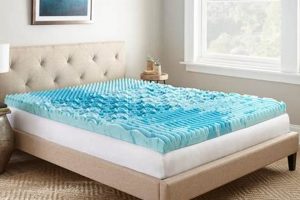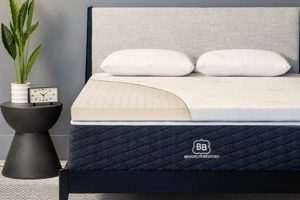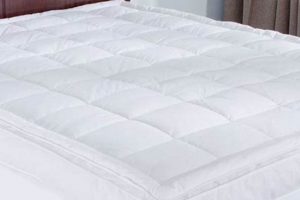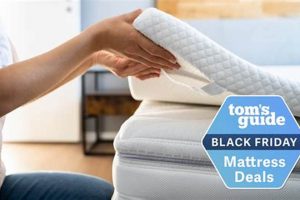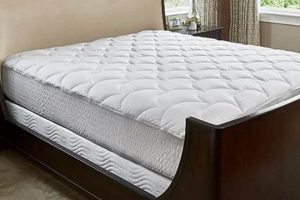A supplementary layer designed to enhance the comfort of a standard dormitory bed. Typically constructed from materials such as memory foam, latex, or fiberfill, it is placed atop the existing mattress to modify its firmness and support characteristics. An example of its use would be placing a gel-infused foam addition onto a hard, thinly padded, standard dorm bed.
These additions play a vital role in improving sleep quality within the often-uncomfortable confines of student housing. The benefits include enhanced spinal alignment, pressure point relief, and mitigation of motion transfer, all contributing to a more restful sleep environment. Historically, students have sought solutions to improve the discomfort of standard-issue beds, with these supplemental layers evolving as a popular and effective remedy.
Subsequent discussion will cover the various types available, factors to consider when selecting one, and maintenance tips to ensure longevity and hygiene. This article aims to provide a comprehensive guide for students seeking to optimize their sleeping arrangements in a dorm setting.
Tips for Selecting and Maintaining a Dorm Bed Mattress Topper
Optimizing the sleep environment in a dormitory setting often necessitates careful consideration of comfort-enhancing additions. The following tips provide guidance on selecting and maintaining a suitable product, contributing to improved rest and well-being throughout the academic year.
Tip 1: Material Considerations: Evaluate material composition based on individual needs. Memory foam offers pressure relief and contouring, while latex provides resilience and breathability. Fiberfill options are generally more affordable but may offer less support.
Tip 2: Thickness Assessment: Determine the appropriate thickness based on the firmness of the existing mattress. A thicker product can significantly alter the overall feel, while a thinner one may provide only subtle enhancement.
Tip 3: Size Verification: Ensure accurate size matching to the dormitory bed frame. Inconsistent dimensions can lead to slippage, discomfort, and accelerated wear.
Tip 4: Hypoallergenic Properties: Individuals with allergies should prioritize options with hypoallergenic certifications. This reduces the risk of allergic reactions and respiratory irritation.
Tip 5: Cleaning Protocols: Establish a consistent cleaning regimen based on the manufacturer’s recommendations. Regular vacuuming and spot cleaning can prevent the accumulation of dust mites and allergens.
Tip 6: Protective Covers: Employ a waterproof or water-resistant cover to protect against spills and stains. This extends the lifespan and maintains the hygiene of the addition.
Tip 7: Rotation Schedule: Rotate the enhancement periodically to promote even wear and prevent sagging in specific areas.
Selecting and maintaining the appropriate product enhances the comfort and hygiene of a dorm room sleeping space. By addressing material selection, size, allergen concerns, and implementing a cleaning strategy, students can improve the conditions for restorative sleep.
The subsequent section will explore frequently asked questions regarding the use and care of such sleeping enhancements.
1. Material Composition
Material composition is a foundational consideration when selecting a dorm bed mattress topper. The materials used directly influence comfort, support, durability, and suitability for individuals with allergies or sensitivities.
- Memory Foam
Memory foam, typically polyurethane-based, offers contouring and pressure relief. It conforms to the body’s shape, distributing weight evenly and reducing stress on pressure points. However, memory foam can retain heat, potentially causing discomfort for some users. Density is a key factor, with higher density foams providing greater support and longevity.
- Latex
Latex can be either natural or synthetic. Natural latex is derived from rubber trees and is known for its durability, resilience, and breathability. It offers a supportive and responsive feel, making it a good alternative for those who find memory foam too enveloping. Synthetic latex, while more affordable, may not possess the same level of durability or breathability.
- Fiberfill
Fiberfill, often polyester or a blend of synthetic fibers, provides a softer and more affordable option. These offer less support and contouring compared to memory foam or latex. Fiberfill is lightweight and easy to care for, but it tends to compress over time, reducing its effectiveness. They are generally best suited for students looking for a minimal and inexpensive comfort boost.
- Gel-Infused Materials
Gel-infused memory foam or other materials are designed to mitigate heat retention, a common issue with traditional memory foam. The gel particles help to dissipate heat, creating a cooler sleeping surface. The effectiveness of gel infusion can vary depending on the concentration and distribution of the gel particles.
The selection of appropriate materials requires careful consideration of individual preferences, budgetary constraints, and any specific health or environmental concerns. Choosing the right material impacts the overall comfort and support derived from the product, directly affecting sleep quality in the challenging environment of a dormitory.
2. Thickness options
Thickness options in a dorm bed mattress topper dictate the degree of comfort and support alteration to the existing mattress. A thicker topper inherently provides a more significant cushioning effect, potentially masking the inadequacies of an old or uncomfortable dormitory bed. Conversely, a thinner profile offers a subtle enhancement, suitable for beds that require only minor adjustments. For example, a student experiencing back pain due to a very firm mattress might opt for a 3-4 inch thick memory foam topper, while another simply seeking a slightly softer surface may find a 1-2 inch option sufficient. The selection directly influences the level of pressure relief and spinal alignment achieved.
The interplay between the existing mattress firmness and the chosen thickness is critical. A very soft mattress paired with a thick, plush topper could lead to excessive sinking and poor support, negating the intended benefits. Therefore, a careful assessment of the existing bed’s condition is paramount before selecting a topper thickness. Furthermore, logistical considerations, such as sheet fit and overall bed height, also factor into the decision. A very thick topper may require deep-pocket sheets and could make it difficult to get in and out of bed for individuals with mobility challenges.
In summary, the appropriate thickness of a dorm bed mattress topper
is not a one-size-fits-all solution. It is a function of the existing mattress’s properties, individual comfort preferences, and practical limitations. Understanding the cause-and-effect relationship between thickness and support, as well as considering logistical factors, is essential for maximizing the benefits of this sleeping surface enhancement in a dormitory setting.
3. Size Compatibility
Size compatibility represents a fundamental criterion in the selection and utilization of a dorm bed mattress topper. Precise dimensional alignment between the topper and the underlying mattress is essential for optimal comfort, support, and overall functionality. Deviations from correct sizing can compromise the intended benefits and introduce practical challenges.
- Standard Dormitory Dimensions
Dormitory beds frequently adhere to non-standard dimensions, often utilizing ‘Twin XL’ sizes, which are longer than standard twin mattresses. A mismatch between the product and the bed size can result in overhang, underhang, or bunching, disrupting the sleeping surface’s integrity. Incorrect sizing can lead to uneven weight distribution, accelerating wear and potentially diminishing the supportive characteristics of the dorm bed mattress topper.
- Fitted Sheet Accommodation
The addition of the product alters the overall height of the sleeping surface, impacting the fit of standard fitted sheets. If a product is particularly thick, regular sheets may not adequately cover the mattress and topper, leading to slippage and discomfort. Deep-pocket sheets specifically designed to accommodate thicker mattresses and toppers may be required to ensure a secure and smooth sleeping surface. This consideration directly affects the user’s convenience and the product’s overall functionality.
- Edge Support and Stability
If the product is significantly smaller than the mattress, a lack of edge support can occur. This can cause instability when sitting or lying near the edges of the bed. Such instability can be particularly problematic for individuals who utilize the edge of the bed for support when getting in and out, potentially increasing the risk of falls or injuries. Consistent and complete coverage is crucial for maintaining stability and preventing such incidents.
- Product Longevity and Warranty
Incorrect size compatibility can inadvertently void a product’s warranty or reduce its lifespan. Stress points created by overhang or bunching can lead to premature wear and tear, particularly along the edges. Manufacturers typically specify appropriate usage conditions, including size compatibility, within their warranty terms. Failure to adhere to these specifications may nullify the coverage, leaving the consumer responsible for replacement or repair costs.
The integration of appropriately sized dorm bed mattress toppers ensures optimal performance and longevity, contributing to an improved sleep environment within the challenging confines of student housing. Accurate measurements and careful attention to size specifications are essential to realize the full benefits of this type of bedding enhancement.
4. Support Level
The support level offered by a dorm bed mattress topper directly influences spinal alignment and pressure distribution, thereby affecting sleep quality. Insufficient support can exacerbate existing back pain or create new discomforts, negating the intended benefit of enhanced sleep. A topper with adequate support maintains the natural curvature of the spine, preventing postural misalignment and reducing muscle strain during sleep. For instance, a student with scoliosis or kyphosis might require a firmer topper to provide the necessary skeletal support, whereas a student without pre-existing spinal issues might prefer a medium-firm topper for general comfort enhancement.
The selection of an appropriate support level necessitates considering body weight and sleeping position. Heavier individuals generally require firmer support to prevent excessive sinking, which can compromise spinal alignment. Side sleepers often benefit from a medium-firm topper that contours to the body while providing adequate support, while back sleepers typically require a firmer surface to maintain proper spinal alignment. Improper support level can lead to pressure buildup in areas such as the hips and shoulders for side sleepers or the lower back for back sleepers, increasing the likelihood of discomfort and disrupted sleep.
Ultimately, the “Support Level” component of a dorm bed mattress topper is critical for promoting restorative sleep. Overlooking this facet can lead to exacerbated discomfort and undermine the product’s purpose. Proper consideration of individual physical needs, sleeping habits, and the properties of the existing mattress allows for the selection of a topper that effectively enhances support and promotes optimal spinal health during rest within the often-challenging environment of student housing.
5. Hygiene maintenance
The maintenance of hygiene in dorm bed mattress toppers is of paramount importance due to the extended usage and potentially unsanitary conditions inherent in dormitory environments. These spaces often experience high traffic, limited ventilation, and infrequent professional cleaning, creating a breeding ground for allergens, bacteria, and dust mites. Neglecting routine cleaning protocols can lead to the accumulation of these contaminants within the topper material, negatively impacting respiratory health and potentially triggering allergic reactions in susceptible individuals. For example, a student with asthma may experience increased symptoms if the mattress topper is not regularly cleaned to remove dust mites.
Appropriate hygiene maintenance involves a multifaceted approach, including the use of protective covers, regular vacuuming, and occasional spot cleaning. Waterproof or water-resistant covers serve as a barrier against spills, sweat, and other bodily fluids, preventing them from penetrating the topper’s core. Routine vacuuming removes surface debris, dust mites, and allergens, while spot cleaning addresses localized stains or spills with appropriate cleaning solutions. The frequency of these maintenance tasks should be adjusted based on the level of usage and environmental conditions. For instance, a topper used in a humid climate may require more frequent cleaning to prevent mold or mildew growth. Furthermore, many toppers come with manufacturer guidelines for cleaning; these should be followed to avoid damaging the materials.
In conclusion, consistent and diligent hygiene maintenance is critical for preserving the cleanliness, comfort, and longevity of a dorm bed mattress topper. This practice minimizes the risk of allergen exposure, inhibits bacterial growth, and prolongs the useful lifespan of the product, ultimately contributing to a healthier and more restful sleep environment for students residing in dormitory settings. Failure to prioritize hygiene can undermine the benefits of the topper and expose the user to potential health risks.
Frequently Asked Questions
This section addresses common inquiries regarding the se
lection, use, and maintenance of dorm bed mattress toppers. The information presented aims to provide clarity and guidance for individuals seeking to enhance their sleep environment within dormitory settings.
Question 1: How does a dorm bed mattress topper improve sleep quality?
A dorm bed mattress topper alters the surface characteristics of the existing mattress, providing enhanced cushioning, pressure relief, and support. This can lead to improved spinal alignment, reduced tossing and turning, and ultimately, a more restful sleep experience.
Question 2: What is the typical lifespan of a dorm bed mattress topper?
The lifespan is contingent upon material quality, usage frequency, and maintenance practices. High-quality toppers, properly maintained, can last for several years. However, cheaper materials or inadequate care may shorten the lifespan to a single academic year.
Question 3: Can a dorm bed mattress topper alleviate back pain?
A carefully selected topper can potentially alleviate back pain by providing improved spinal support and pressure relief. Memory foam and latex options are commonly recommended for this purpose. However, it is advisable to consult a healthcare professional for persistent or severe back pain.
Question 4: What are the potential hygiene concerns associated with dorm bed mattress toppers?
Toppers can accumulate dust mites, allergens, and bacteria over time, particularly in the humid environments often found in dormitories. Regular cleaning and the use of protective covers are essential to maintain hygiene and prevent allergic reactions.
Question 5: How should a dorm bed mattress topper be cleaned?
Cleaning methods vary depending on the material. Many toppers can be spot cleaned with mild detergent and water. Some may be machine washable, while others require professional cleaning. Always consult the manufacturer’s instructions prior to cleaning.
Question 6: What factors should be considered when choosing a dorm bed mattress topper?
Key factors include material composition, thickness, size compatibility, support level, and hypoallergenic properties. Individual preferences, budgetary constraints, and any specific health concerns should also be taken into account.
The information provided addresses fundamental concerns regarding dorm bed mattress toppers. Careful consideration of these points can guide informed decision-making and maximize the benefits of this type of sleep enhancement.
The subsequent section will provide a brief conclusion summarizing the key takeaways discussed throughout this guide.
Conclusion
This article has explored the attributes and benefits of a dorm bed mattress topper. It addressed material selection, size compatibility, support levels, and hygiene maintenance. The importance of selecting the proper product to enhance comfort and promoting sound sleep in a dormitory was emphasized. The information presented is essential for students seeking to improve their sleeping conditions within the challenging environment of student housing.
As individuals navigate the unique constraints of dormitory living, the benefits derived from a dorm bed mattress topper are significant. By applying the knowledge provided, students can foster a more restorative rest environment, contributing to improved academic performance and overall well-being. Thoughtful product selection and conscientious care are paramount for realizing the full potential of this important sleep enhancement.


